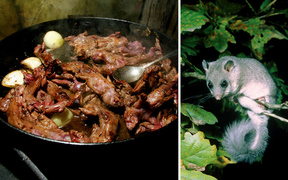 Yum. Crunch. Yum. Crunch. You know, I always thought I'd have a problem eating weird things if I ever traveled in the Orient. I'm a person with a fairly narrow palette... I admit it. Lucas has a much broader palette than I do. I like what I like and won't try what I know I don't like. I'm old enough to say that I have tried lots of stuff (for instance, I hate caviar) and know what I can't stomach. In my research and travels about Italy, I've come across things that I wouldn't eat if you paid me. Some things I'll try--once--while others... well, you just sort of know to stay clear. Stuffed Mice There is a protected, fluffy tailed species of dormice that have been eaten since the days the Caesars ran things. Down in Calabria the rodents are still stuffed and chomped on. They are stuffed with meat, nuts, raisins, onions and spices. You can imagine little squeaks as you take a bite. I have no idea what they do with all those cute fluffy tails. 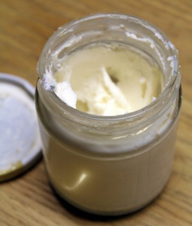 This stuff will burn your nose. This stuff will burn your nose. Riccota Forte (or Scanta) Down in Puglia, they are a resourceful bunch. Many of you may know that ricotta means twice cooked or re-cooked... basically, ricotta is a by-product of normal, everyday cheese making. You take the little bit of whey left over, add an acid, boil it and presto, you have ricotta cheese. It's a fresh cheese and should be eaten within a couple of days. When it dries out, the frugal Puglese add salt, and let it dry even more into Ricotta Salada. But they go even further. Some just let it go bad... and stinky... and turn it into a Puglia delicacy called Ricotta Forte, or Scanta. Many think this acrid, foul smelling cheese is worse than any other stinky cheese they've even eaten--but in a good way. We tried it during our stay in a Puglese trullo pointy house. Yes, it stinks, and our host told us how it's just kept in a dark, un-refrigerated place to grow more bacteria and even sometimes minute worms--but we actually liked it! (It did burn my eyes a tad). It's the kind of taste that shocks your eyes open, assaults your nose but somehow in the end pleases your palette. It's also a surprise when you are first introduced to it in a plain jar that looks like it's your Aunt's nine year old, home brew face cream. Enjoy. (Oh, just don't get it on anything sweet... I got it on some Nutella and bread by mistake and nearly got whiplash when I popped it in my mouth.) 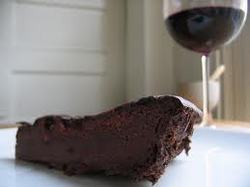 Dracula would love this stuff Dracula would love this stuff Tuscan Blood Torte Enough said. A torte or cake made from the blood of pigs. I've tried Argentinian blood sausage and British blood sausage, and if the flavor is anything close to what I experienced, I would never go near this stuff. It sort of looks like what came out of me the time I was bleeding internally from gastritis... I know, TMI. Ugh. 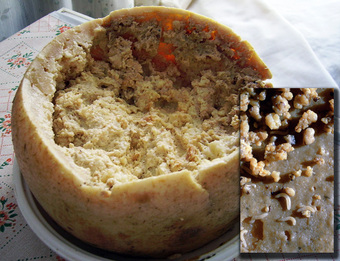 "Casu Marzu cheese", copyrighted by Shardan "Casu Marzu cheese", copyrighted by Shardan Casu Marzu or Formaggio Marcio (Rotten Cheese), with maggots Casu Marzu is a sheep milk cheese from Sardinia and Corsica (they call it Casgio Merzu) that actually contains maggots--live ones. Most cheeses rely on fermentation and bacteria to develop their flavor, but this cheese relies on actual decomposition caused by the Cheese Fly larvae. The texture is oozing, seeping liquid essentially caused by... well... maggot poop. Some people eat this stuff with the larvae, some will tickle the cheese, causing the larvae to be disturbed enough to actually jump out... as much as 6 inches! The daring who have tasted it say this muck is so acidic that it leaves an after taste in your mouth for hours afterward. There was a cheese like this in France I experienced years ago--I wouldn't go near that either! 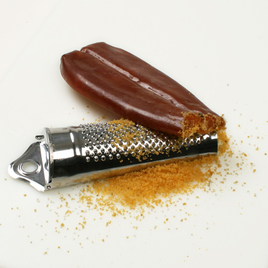 Mullet Bottarga Mullet Bottarga Bottarga From what I hear, battarga is definitely an acquired taste that's at least a thousand years old and likely more ancient than that. It's made from the roe (fish egg) pouch of either grey mullet or Atlantic bluefin tuna. The roe pouch is manipulated by hand to get rid of any air bubbles and then cured in sea salt for several weeks. After curing, the result is a hard, dried salty slab which is usually (but not always) coated in beeswax. To use it, you grate some on top of pasta or on top of crostini (toasted bread) and drizzled with olive oil. It also can be used as a main ingredient along with garlic for tomato sauce. It has a tremendously long shelf life and is often smuggled out of Italy due to its high price--up to $140 a pound! 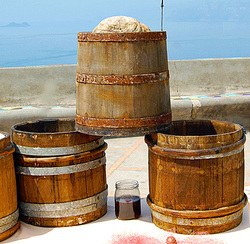 Colatura barrels Colatura barrels Colatura di Alici, fish sauce from Amalfi In ancient Roman times there was a fishy concoction called garum, a clear sauce made from salting and compression various types of fish. The clear garum on top was used by the upper classes, while the sludge left over, called allec, was used by the lower classes to add flavor to polenta, porridge or on bread. Today there is a modern version called Colatura di Alici made in one of my favorite villages on the Amalfi Coast, Cetera. The first time I took a tour of Cetera at ground level on Google Earth I started seeing barrels and wondered why this village had so many. It's a fairly simple recipe...
The golden liquid is prized in Italy and is used to flavor all sorts of dishes. Watch the video of Colatura being made... 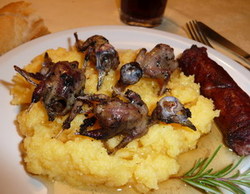 Everything, including the little beak. Everything, including the little beak. Songbirds Yes, the same birds I head waking up on Tuscan mornings are being shot or captured in hanging nets by hunters to supply their illegal bounty to restaurants throughout Italy. Sure, it's illegal, but hey... making a buck and not getting caught is considered furbo in Italy (do a search on this blog for my article on furbo). It seems this is an elite recipe item in Italy. Ladies and gents get dressed up in all their finery and make an event out of eating these little skylarks, goldfinches and other types of song birds. Our hot air balloon pilot, Stephano told us they shoot anything in Italy, especially song birds, so much so that some species are becoming endangered. The little tweetys are usually stuffed with pork, beef, rabbit or even other birds. They are served with their heads and beaks on top of polenta, looking like a sweet bird's nest. To show you how nuts Italians are about eating song birds, there is even a dessert made to look just like the infamous songbird and polenta favorite... It's called polenta e osei and made to look just like the real dish. It's made of a soft light sponge cake filled with hazelnut cream that is rolled in a yellow fondant. On top is a little chocolate bird (or birds) made from chocolate marzipan. You can find this in the town of Bergamo. As for the real song bird dish, the macho thing is to pick up the birdie by the beak and leave nothing... devouring bones, beak and all. (I remember a similar song bird fetish in France years ago). Poor Tweety would say, "I tawt I taw an Italian! I did, I did taw an Italian! Help, Nonna!" 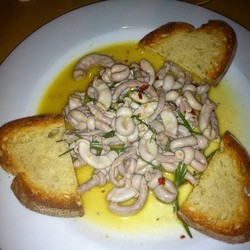 Disgustoso! Non grazie! Disgustoso! Non grazie! Pajata cheese from cow's intestines This is either a Roman dish or what the Devil himself would order up. A young, milk fed (no grass fed) calf is slaughtered, and besides getting veal from it, its intestines are used to make this delicacy--pajata. The intestines are washed, but not emptied. When cooked, the partially-digested milk inside turns into a thick, funky cheesy substance which is used as a pasta sauce, and often served on its own with crostata. No thanks! Il conto, per favore! 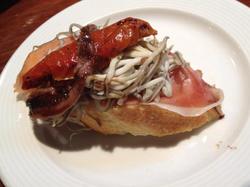 No bones about it... just good, young eel. No bones about it... just good, young eel. Cieche, Baby Eels Cieche are baby eels that migrate upriver after being born in the sea. The name, Cieche literally means blind – these babies have no eyes. In coastal areas of Tuscany, cieche are usually fried or boiled alive. Just be careful they don't jump out when you're trying to dump them into the boiling water or saute pan.  You call THIS pizza?? You call THIS pizza?? Vending Machine Pizza As this article proves, Italians will eat anything... but, even pizza made totally inside a robotic vending machine? Let's Pizza machines were initially designed and manufactured in Northern Italy. It offers a choice of four kinds of pies, and makes the pizza while you watch the whole process through windows--- adding water to flour, kneading the dough, places the sauce and toppings, and bakes the pizza in an infrared oven in just 2.5 minutes. It can produce 90 to 100 pizzas before it needs to be refilled. --Jerry Finzi
2 Comments
jessica mcnamara
3/25/2020 06:55:46 pm
Is this why the Corona virus is now devastating Italy?
Reply
Jerry Finzi
3/31/2020 12:29:20 pm
No chance of this. The scientific research points to bats in China (and Orient in general) that mutated this coronavirus strain, and perhaps (no hard evidence at this point) transferred to an intermediate host... the most probably culprit is the Civet Cat. It's not a cat at all, but more like a weasel that is commonly eaten in China, India, etc. The theory is that since the bats and civet cats are both fruit eaters and might have been spreading the disease to each other by eating the same fruits and visiting the same trees. Humans trap, kill and prepare the civet cat for food. They even use the scent glands of the animals. Still... they are still trying to find hard evidence.
Reply
Your comment will be posted after it is approved.
Leave a Reply. |
Categories
All
Archive
June 2024
|


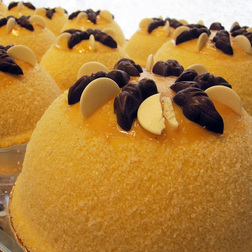
 RSS Feed
RSS Feed
